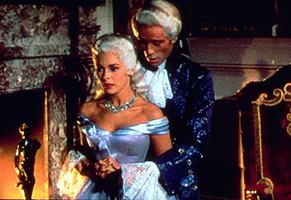

USA action
1952
color 115 min.
Director: George Sidney
CAV: out-of-print collectible
2 discs, catalog # CC1132L
CLV: out-of-print collectible
1 disc, catalog # CC1193L

Prior to the success of
Scaramouche in 1952, many in Hollywood felt that the big-budget
"swashbuckler" film was no longer a safe investment. While such motion pictures
as M-G-M's version of The Three Musketeers (directed by George Sidney --
1948) and Twentieth Century Fox's version of Rafael Sabatini's The Black
Swan (Henry King Ð- 1942) were hugely successful, the various studios decreed
that such comparatively costly efforts were highly impractical in the
costconscious post-war years. It came as no surprise, therefore, that when the
idea of remaking Metro-Goldwyn-Mayer's 1923 silent version of Rafael Sabatini's
Scaramouche was first proposed at a projected cost of $3.5 million, many
M-G-M executives were apprehensive. When one compares the proposed budget for
Scaramouche to other M-G-M budgets of that time (An American in
Paris -- $2.7 million; Show Boat -- $2.3 million; Singin' in the
Rain -- $2.5 million), one can appreciate the executives' concerns.
Once
given the grudging goahead, M-G-M threw caution to the wind and spared no expense
in bringing to life the delightfully witty script of Ronald Millar and George
Froeschel. Eye-popping color photography (in lush 3-strip Technicolor) by Charles
Rosher, magnificent 18th-century sets by Cedric Gibbons and Hans Peters and
costumes by Gile Steele, and a buoyantly melodic score by Victor Young (borrowed
from Paramount) -- all were utilized to full effect under the splendid direction
of George Sidney, whose sense of movement and visual flair reached its peak with
this production.
The cast would seem impossible to improve upon, yet it is
interesting to note that Scaramouche was first conceived as a vehicle for
Gene Kelly. At a later point, it was announced that Stewart Granger would play
both the lead and the role of the Marquis. A few months later, it was announced
that Fernando Lamas and Ricardo Montalban would assume the respective parts
instead, with Ava Gardner as Lenore and Elizabeth Taylor as Aline.
As it
fortuitously turned out, Stewart Granger ultimately played Andre Moreau, and with
such brilliance and flair that he reintroduced and redefined the concept of the
superstar swashbuckler. Eleanor Parker (previously a Warner Brothers star) played
the sultry Lenore so convincingly that her performance resulted in an M-G-M
contract.
The careers of Janet Leigh and Mel Ferrer were given a considerable
boost by their laudable portrayals of the beauteous Aline and the icy Marquis de
Maynes.
The excellent supporting cast includes Nina Foch as the stunningly
sardonic Marie Antoinette, Henry Wilcoxon as the cold and calculating Captain of
the Guard, Robert Coote as the buffoonish theatrical manager, and Lewis Stone
(who starred as the Marquis in M-G-M's silent version of Scaramouche) as
the warm and avuncular guardian of our hero. (The only case of possible
miscasting, though an amusing one, would be Richard Anderson, who appears, to
some, uncomfortable in costume as the young Philippe.)
No comments about
Scaramouche would be complete, however, without mentioning the final duel,
the longest and most elaborate in film history. Running an unprecedented
six-and-a-half minutes, it was supervised and staged by Jean Heremans, who at the
time was the fencing master at the Los Angeles Athletic Club.
This bravura set
piece is an unparalleled accomplishment in the annals of cinema swashbuckling.
Sidney's fluid camera tracks hero and villain as they fence each other along the
edges of the theatre boxes, down the main staircase, through the foyer, into the
auditorium and onto the stage -- in the process demolishing virtually every prop
in sight. Not a note of background score distracts us, as the soundtrack
reverberates with the sound of clashing steel. (It should be noted that with the
exception of one fall from a balcony onto a couch, Mr. Granger performed the
sequence without the use of a double.)
Scaramouche opened at Radio City
Music Hall on June 26, 1952 to rapturous reviews and resounding box office. As a
result, Stewart Granger officially joined the ranks of that select group of film
stars (Douglas Fairbanks, John Barrymore, Errol Flynn and Ronald Colman) whose
on-screen personas embodied and perpetuated the myth of the
"swashbuckler."
Today, the romantic gesture, the clownish vivacity, the
balletic grace blended with a swaggering sense of style and flair, the
championing of all the important virtues -- everything incarnate within the
swashbuckling hero -- may be considered anachronistic by some. But that doesn't
stop many of us from reliving the exhilaration we feel when we watch
Scaramouche.
-- DICK DINMAN
Credits
Director: George
Sidney
Screenplay: Ronald Millar, George Froeschel
Based on a novel by:
Rafael Sabatini
Director of Photography: Charles Rosher, A.S.C.
Film
Editor: James E. Newcom, A.C.E.
Music: Victor Young
Art Directors: Cedric
Gibbons, Hans Peters
Special Effects: A. Arnold Gillespie, Warren
Newcombe
Fencing Master: Jean Heremans
Costume Designer: Gile
Steele
Technicolor Color Consultants: Henri Jaffa, James Gooch
Recording
Supervisor: Douglas Shearer
Set Decorators: Edwin B. Willis, Richard
Pefferle
Transfer
This edition of Scaramouche was
transferred from M-G-M's original negative. The soundtrack was mastered from a
35mm magnetic track.






